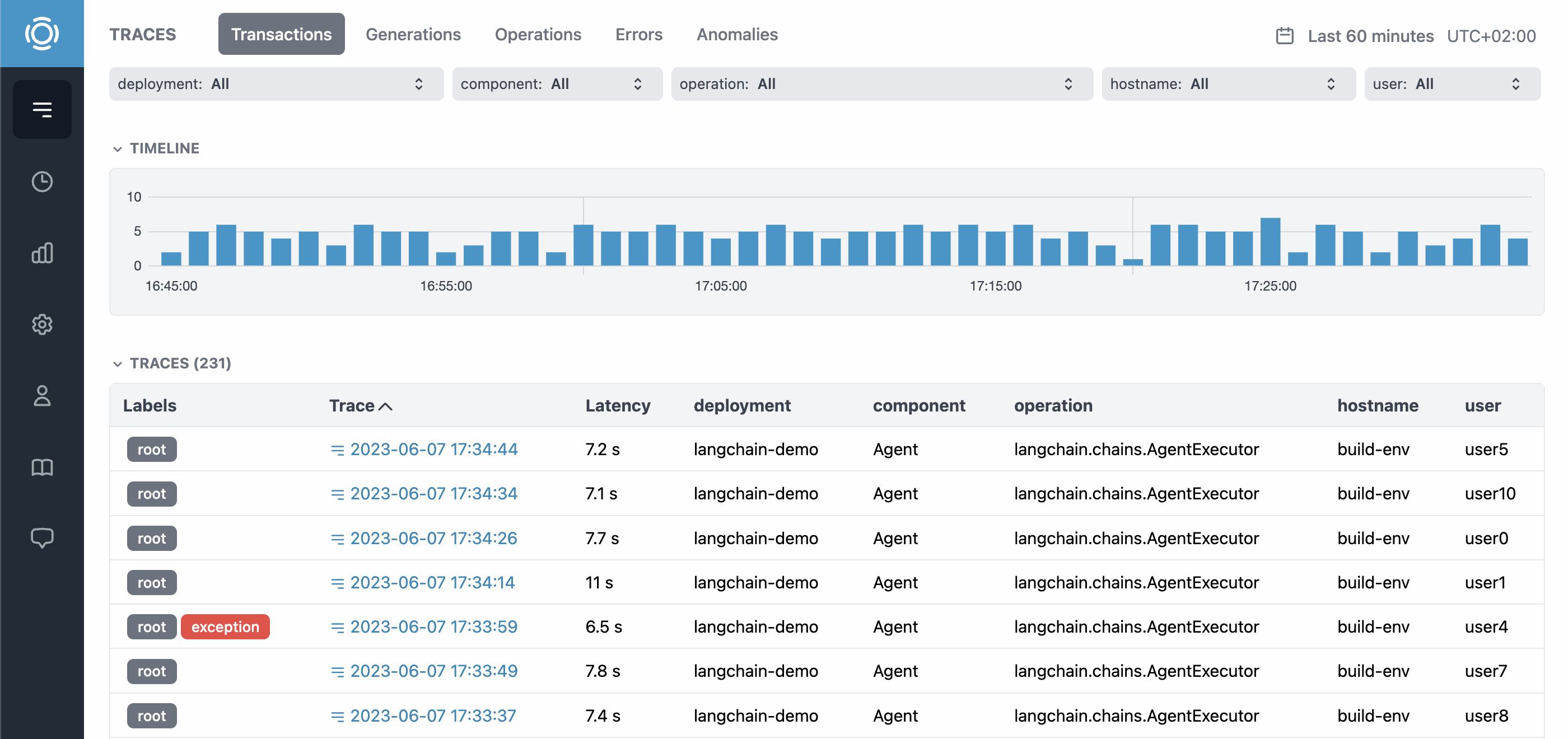Graphsignal Tracer
Project description
Graphsignal: Observability for AI Stack
Graphsignal is an observability platform for AI agents and LLM-powered applications. It helps developers ensure AI applications run as expected and users have the best experience. With Graphsignal, developers can:
- Trace generations, runs, and sessions with full AI context.
- Score any user interactions and application execution.
- See latency breakdowns and distributions.
- Analyze model API costs for deployments, models, or users.
- Get notified about errors and anomalies.
- Monitor API, compute, and GPU utilization.
Learn more at graphsignal.com.
Install
Install Graphsignal library by running:
pip install --upgrade graphsignal
Or clone and install the GitHub repository:
git clone https://github.com/graphsignal/graphsignal-python.git
python setup.py install
Configure
Configure Graphsignal tracer by specifying your API key directly or via GRAPHSIGNAL_API_KEY environment variable.
import graphsignal
graphsignal.configure(api_key='my-api-key', deployment='my-app')
To get an API key, sign up for a free account at graphsignal.com. The key can then be found in your account's Settings / API Keys page.
Alternatively, you can add Graphsignal tracer at command line, when running your module or script. Environment variables GRAPHSIGNAL_API_KEY and GRAPHSIGNAL_DEPLOYMENT must be set.
python -m graphsignal <script>
python -m graphsignal -m <module>
Integrate
Automatic integration
Graphsignal auto-instruments and traces libraries and frameworks, such as OpenAI and LangChain. Traces, errors, and data, such as prompts and completions, are automatically recorded and available for analysis at app.graphsignal.com.
Some integration examples are available in examples repo.
Session tracking
Session groups multiple traces together to represent a run, thread, conversation or user interactions. Session tracking allows session-level visualization, analytics and issue detection.
Set a session identifier as session_id tag for every request, e.g. in a request handler:
graphsignal.set_context_tag('session_id', session_id)
or directly, when tracing manually:
with graphsignal.trace(tags=dict(session_id=session_id)):
...
If you are running a single process per session and added Graphsignal at command line, you can set the session_id tag in an environment variable.
env GRAPHSIGNAL_TAGS="session_id=123" python -m graphsignal <script>
User tracking
User tracking allows grouping and visualization of user-related traces, interactions, metrics, and costs. It also enables detection of user interaction outliers and other issues.
To enable user tracking, set user identifier as user_id tag for every request, e.g. in a request handler:
graphsignal.set_context_tag('user_id', user_id)
or directly, when tracing manually:
with graphsignal.trace(tags=dict(user_id=user_id)):
...
You can additionally set user_name and user_email tags.
If you are running a single process per user and added Graphsignal at command line, you can set the user_id tag in an environment variable.
env GRAPHSIGNAL_TAGS="user_id=123" python -m graphsignal <script>
Scores and feedback
Scores allow recording an evaluation of any event or object, such as generation, run, session, or user. Scores can be associated with events or objects using tags, but can also be set directly to a span.
Tag request, run, session, or user for each request or run:
graphsignal.set_context_tag('run_id', run_id)
or directly, when tracing manually:
with graphsignal.trace('generate', tags=dict('run_id', run_id)):
...
Create a score for a tag. This can be done at a later time and/or by other application. For example, when user clicks thumbs-up or thumbs-down for a request or a session:
graphsignal.score('user_feedback', tags=dict('run_id', run_id), score=1, comment=user_comment)
You can also associate a score with a span directly:
with graphsignal.trace('generate') as span:
...
span.score('prompt_injection', score=0.7, severity=2)
See API reference for more information on graphsignal.score and Span.score methods.
Use REST API to upload scores from any application or environment.
Manual tracing
To measure and monitor operations that are not automatically instrumented, wrap the code with trace() method or use @trace_function decorator.
To record payloads and track usage metrics, use Span.set_payload().
with graphsignal.trace('my-operation') as span:
...
span.set_payload('my-data', data, usage=dict(size=my_data_size))
@graphsignal.trace_function
def my_function():
...
When tracing LLM generations, provide payloads in OpenAI format, which is supported by Graphsignal. Set model_type='chat' tag and add input and output data as input and output payloads respectively.
with graphsignal.trace('generate', tags=dict(model_type='chat')) as span:
output_data = my_llm_call(input_data)
...
span.set_payload('input', input_data, usage=dict(token_count=input_token_count))
span.set_payload('output', output_data, usage=dict(token_count=output_token_count))
For auto-instrumented libraries, or when using @trace_function decorator, trace() method with with context manager or callbacks, exceptions are automatically recorded. For other cases, use Span.add_exception.
Analyze
Log in to Graphsignal to monitor and analyze your application and monitor for issues.
Overhead
Graphsignal tracer is very lightweight. The overhead per trace is measured to be less than 100 microseconds.
Security and Privacy
Graphsignal tracer can only open outbound connections to api.graphsignal.com and send data, no inbound connections or commands are possible.
Payloads, such as prompts and completions, are recorded by default in case of automatic tracing. To disable, set record_payloads=False in graphsignal.configure.
Troubleshooting
To enable debug logging, add debug_mode=True to configure(). If the debug log doesn't give you any hints on how to fix a problem, please report it to our support team via your account.
In case of connection issues, please make sure outgoing connections to https://api.graphsignal.com are allowed.
Project details
Release history Release notifications | RSS feed
Download files
Download the file for your platform. If you're not sure which to choose, learn more about installing packages.















